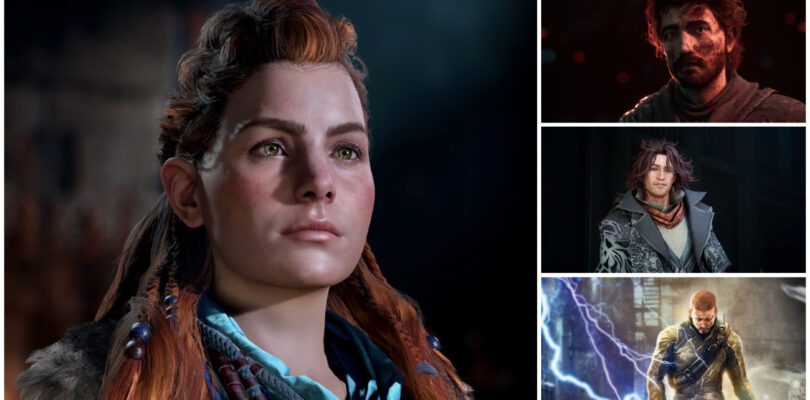One thing that never changes in our industry: plot twists will always be present in video games. And that is a beautiful thing, as we have already established how good writing can usually drive—maybe even carry—an entire game.
And as always is the case, every year, gaming has one if not more surprises in their stories that leaves us all “whoa” faced. Of the top of our heads, we can think of several examples: from Silent Hill to Metal Gear, from Call of Duty and even the likes of Ghost Recon, people have seen their fair share of plot twists in video games.
So we took upon ourselves to remind you of a bunch of others, equally impressive sudden changes in stories told in gaming. Oh, and this should be obvious by now, but there will be spoilers ahead.
Note: Affiliate Disclosure: At PlayRatedGames, our content is made possible by our readers. If you purchase a game or product through links on our site, we may receive a small commission. This support helps us continue publishing honest, independent reviews. Our recommendations are based solely on what we believe offers real value to players — never influenced by affiliate partnerships.
I DID NOT SEE THAT COMING
- Cole and Kessler’s are one and the same (InFamous)
- Ardyn is Noctis’ forefather (Final Fantasy XV)
- The Dual Identity of Marika and Radagon (Elden Ring)
- The End of the World through Hubris (Horizon Zero Dawn)
- Ebina’s True Role and Kiryu’s Redemption (Like a Dragon: Infinite Wealth)
- The Simulation and Clones of Project Ark (3 Sentinels: Aegis Rim)
- Colt and Julianna’s Familial Bond (Deathloop)
- Selene’s Trauma and the Metaphorical Loop (Returnal)
- The Canvas World Revelation (Clair Obscur: Expedition 33)
Cole and Kessler’s are one and the same (InFamous)
We all know how busy Sucker Punch studios is nowadays, what with Ghost of Yōtei coming up (October can’t come soon enough!), but I remember vividly the moral mechanics in InFamous’ gameplay. The ability to drive certain elements of the story wasn’t exactly new at the time, but few games managed to implement it so well back then.
Even more so when the story progresses to its climax, fighting big bad Kessler and…wait, why does he have the same powers as Cole MacGrath? Is he somehow connected with our hero? In a way that the game never gave any proper understanding?
Yes, yes he very much is. You see, Kessler is Cole.
In what was one of the major plot twists in video games in the PlayStation 3 era, Kessler went through the same ordeal we did while running around with Cole and his newly-gifted electric powers. Except, when his perfect opposite—The Beast—came to be, he chose to take his family and run, leaving Empire City to burn in the enemy’s rampage.
He failed. He lost everything: his city, the love of his life, his family…so he hatched a plan: go back in time, find his past self, engineer the entire accident that leveled Empire City and gave Cole his powers, and subtly nudge him in the path he himself never followed.
Hell, he even killed his wife’s past version just to ensure Cole would be ready with no distractions.
Say what you will about Kessler, but the man was unyielding to the very end…
Ardyn is Noctis’ forefather (Final Fantasy XV)
I won’t lie, since the “Tidus doesn’t really exist and Auron has been dead this whole time” twists in Final Fantasy X, Square Enix’s main RPG franchise has been lacking in the “impressive story turns” departments.
Ever since Final Fantasy XV came into the picture, however, I’ve managed to regain some of the hope for excellent writing—and as plot twists in video games go, main antagonist Ardyn Izunia’s character development makes one hell of a delivery.
You see, first introduced as “a man of no consequence” in the game’s early hours, it became obvious that Ardyn was much more than he let on, but man, were we in for a ride: not only he’s the main orchestrator of the entire conflict between the warring kingdoms of Lucis and Nilfheim, Ardyn Izunia is also responsible for the Starscourge that brought about the demons… And he’s also the protagonist Noctis’ forefather.
Yup, Ardyn’s real name is “Ardyn Lucis Caelum”, and not only is he several generations older than Noctis within the bloodline, he was actually meant to be the first King and the one to end the curse he himself began.
Oh, and he planned the entirety of all events past and present just so he could ensure Noctis’s birth, development and full on evolution into the legendary True King… In order to kill him and spite the gods. What’s even worse… He was not completely without reason.
And you thought your family was complicated…
The Dual Identity of Marika and Radagon (Elden Ring)
In the expansive and enigmatic world of Elden Ring, there are a lot of twists and turns that make 2022’s Game of The Year one of the most interesting narratives in the market to this day: from the Frenzied Flame not being necessarily evil to the Omen’s horns actually being a sign of blessing, this creation from Hidetaka Miyazaki is chock-full of narrative nooks and crannies that will have you exploring and reading stuff for a long time.
However, few, if any at all, match the sheer amount of “wait, what” expressions made when Queen Marika’s true nature came to light: introduced in tandem with Radagon of the Golden Order, both names were initially presented as distinct, albeit connected, powerful entities. Marika, the vanished queen, whose absence drives much of the narrative; and Radagon, her second husband who left to marry the sorceress Queen Rennala.
Psyche, noob! The game had you fooled all along, and turns out, Marika and Radagon are… The same? The groundbreaking revelation comes when you cast the Law of Regression incantation in front of Marika’s statue after exiting her chambers. This unveils a singular, dual-natured deity at the very core of the Lands Between, fundamentally altering the perceived cosmic order.
Back in the day, this was one of the major plot twists in video games, simply due to the fact that Elden Ring already a densely detailed lore to begin with, and by revealing Marika/Radagon as one single being turned the entire canon on its head, forcing players to re-read everything they thought they knew under a new perception.
It is as most writers say: one single detail can change everything you see about certain literatures…
The End of the World through Hubris (Horizon Zero Dawn)
Many open-world games struggle with their own narratives, simply because there’s so much to do that lore details tend to get lost in the chaos. Exceptions to this rule include Witcher, Red Dead Redemption, Ghost of Tsushima… And Horizon Zero Dawn. In fact, the latter—a Guerrilla Games production—initially presents itself as a lush, post-apocalyptic world teeming with animalistic machines, with humanity regressed to tribal societies. As the outcast Aloy, players embark on a journey to uncover her past and the secrets of the “Old Ones,” slowly piecing together the events that led to, we would find out later, the collapse of civilization.
However, the end of the world is just a small part of the actual plot twist: the true revelation hits when Aloy discovers the grim truth behind the “Metal Devils” and the “Faro Plague.” It’s disclosed that these machines, far from being mystical or alien in nature, were a product of humanity’s own hubris—self-replicating, bio-mass consuming robots designed for war that spiraled out of control. Further into the story, through the Project Zero Dawn logs, Aloy learns that “GAIA” was the AI designed to terraform and reseed the planet after the Faro Plague rendered it barren, and Aloy herself is a clone of Dr. Elisabet Sobeck,” the brilliant scientist who initiated the project.
This entire line reframes the perceived ancient catastrophe, revealing it not as a supernatural event, but as a technological apocalypse of humanity’s own making. It effectively subverts the “ancient evil” trope by giving it a layer of chilling, self-inflicted realism: it’s a classic—albeit beautifully rendered—tragedy, where the present-day struggles are a direct consequence of past human arrogance, and the monsters aren’t mythical beasts, but echoes of a forgotten, technological folly.
And the fact that Horizon Zero Dawn offers such a rich world to explore, you’ll be uncovering these mysteries for quite some time…
Ebina’s True Role and Kiryu’s Redemption (Like a Dragon: Infinite Wealth)
When SEGA’s crime-drama franchise, Yakuza, made the leap from a third-action 3D beat’em-up to a turn-based, old school RPG mechanic, that, in and of itself, was a major shock for a lot of people. Luckily, it was a fresh change that gave new life and purpose to an already aging franchise.
Then came Infinite Wealth, the second title under this new system and, as RPGs go, upgraded the storytelling, giving every character ample room to develop, as well as bringing former protagonist Kazuma Kiryu back to the spotlight, this time with a battle all his own.
According to the game’s lore, Masataka Ebina, acting chairman of the Seiryu Clan, nurtures a deep hatred towards the Yakuza, driving him to orchestrate a scheme by luring former yakuza to Nele Island under the guise of offering them a second chance at a lawful life, only to expose them to nuclear waste, causing them to fall ill and die.
In parallel, Kazuma Kiryu tells us right off the bat: he has cancer—terminal, even—and only six months to live. At the game’s final moments, he reconciles with his own identity, answering “Kiryu” as the doctors handling his treatment ask for his name, and as the game ends, it shows us a fitting “passing of the torch” element as SEGA has previously stated that Ichiban Kasuga, Like A Dragon’s new protagonist, is poised to take Kiryu’s place in the lead.
The Simulation and Clones of Project Ark (3 Sentinels: Aegis Rim)
Multilayered narratives can be really problematic if you don’t stop yourself from going overboard. There’s just so much detail when you have parallel plotlines running at the same time, it’s easy to forget what’s a priority and what’s not. Luckily, 3 Sentinels: Aegis Rim does not suffer from that.
You see, everything in this game is a convoluted lie: the “world” the protagonists live in is a simulation operated by something called “Project Ark”. And the project itself is an endeavor to repopulate other planets following humanity’s extinction in 2188—yup, none of the main characters are human, but rather, clones fighting kaijus (in actuality, terraforming mechs) within a portion of the simulation that was infected with a virus that makes the entire thing reset over and over.
This is one of the most praised plot twists in video games exactly because every bit of information adds up to previous knowledge, but nothing is really predictable, so you don’t have any other choice besides moving forward. At the end, there’s a lot of “oh, so that’s why” moments that tie up everything together.
The twist fundamentally redefines the entire premise of the game, transforming it from a straightforward mech-fighting story into a sprawling sci-fi epic that explores humanity’s last hope and the very nature of consciousness. Its ingenuity and intricate plotting garnered significant critical acclaim, solidifying its status as an “incredible” narrative achievement, even if it remains “lesser-known” compared to more mainstream blockbusters.
Oh, and there’s a post-credit scene that touches briefly on AI and its role in this new “world” within the game—a topic the gaming industry itself is often discussing in heated arguments.
Colt and Julianna’s Familial Bond (Deathloop)
As games led by assassins go, Deathloop is probably one of the most entertaining ones: centered on the rivalry between Colt Vahn and Julianna Blake, the enemy duo is trapped within a mysterious time loop on the island of Blackreef. For a significant portion of the game, their interactions are characterized by a deadly cat-and-mouse game, often infused with a playful or antagonistic undertone.
However, as the game progresses and Cole gradually recovers his memory fragments, it is revealed that his main opponent in this is, in fact, his daughter. Lila Blake, Cole’s beloved, passed away, leaving him with a child and entering him into the loop that, until now, we thought was imposed on them both.
Desperately seeking a “paradise” free from grief, Cole eventually forgets his past due to a dissociative mental condition. Julianna, however, retains her memories through each loop, relentlessly trying to to compel her father into remembering their relationship and the underlying reasons for his actions.
It’s the kind of change that forces you to revisit smaller bits of information through new lenses, better understanding Cole’s actions as well as smartly contextualizing neurodivergent conditions through a popular medium such as video games.
Because of this, Colt and Julianna’s lethal encounters take on a new, unsettling meaning once their familial bond is brought to light. While some players found this revelation weird and that it rendered their early encounters pointless (there *was* a flirty moment between them, after all), it also helps others re-evaluate Julianna’s motivations, essentially trying to reconnect with her own father, even if it means going through a more violent approach.
For some, it is rather poetic…
Selene’s Trauma and the Metaphorical Loop (Returnal)
When I first saw Returnal, its very first trailer didn’t throw me off, but it made me think it was just another roguelike game and, as good as it looked, it didn’t really vibe with me. It was only after I had the chance to play it that I noticed how…psychologically defying this title was.
In it, we’re introduced to Selene, an astronaut who crash-lands on the hostile alien planet Atropos and is seemingly trapped in an endless cycle of death and resurrection. However, as the game progresses, we are led to a profound, multi-layered revelation that the events experienced on Atropos are not a literal space mission but a metaphorical representation of Selene’s deep-seated psychological trauma stemming from a real-world car crash, gradually unveiled through fragmented memories and the game’s secret ending.
You see, on said crash, Selene was the driver, and she mentally and physically abandoned her son, Helios, in the crash; the recurring “white shadow” and astronaut figures are manifestations of her guilt and failed aspirations; and her lifelong ambition to be an astronaut was largely influenced by her controlling mother, Theia, who had all the blame for the accident as the game’s early hours led us to believe.
The entire loop is implied to be Selene’s mind grappling with her past while she is “drowning on the brink of death” after the crash.This narrative surprise is incredibly impactful because it fundamentally recontextualizes the entire gameplay loop, transforming a sci-fi action game into a deeply personal, psychological narrative about grief, guilt, and redemption. And the game’s many antagonistic figures are, under this new light, manifestations of Selene’s own perception of the traumatizing event—they’re all meant to be symbolic, giving body to the protagonists internal struggles and the fragmented nature of her memories.
In this, Returnal’s brilliant revelation demonstrates a sophisticated integration of gameplay mechanics and narrative. By revealing the roguelike “loop” as a metaphorical representation of the protagonist’s psychological trauma and internal struggle, the game transforms a core gameplay element into a powerful narrative device.
The Canvas World Revelation (Clair Obscur: Expedition 33)
One thing Clair Obscur: Expedition 33 got much praise for is its turn-based RPG battle mechanics—not that it’s innovative, but the fact that it proved such a system can be expertfully developed within a 3D, hi-end looking game.
But its writing is nothing short of that notion, commencing on a seemingly straightforward, desperate quest: to destroy the mysterious entity known as the Paintress, who annually erases people from existence.
However, the game delivers a mind-bending revelation soon enough: the entire world of Lumiere, where the expedition unfolds, is not a “real” world but a “canvas” – a fantastical creation meticulously crafted by a grieving family, the Descendre family (also referred to as “Madmen”), residing in an “overworld”. The characters with whom the player interacts are revealed to be sentient creations within this canvas, yet some of their creators treat them as mere “puppets” or “imaginary friends”.
Meta-narratives are usually praised whenever they make themselves known: from Star Wars to Frankenstein, the idea of playing with several, seemingly random elements, only to force them into a connection for a grand-arching plot, is what gives way to truly awe-inspiring revelations.
As plot twists in video games go, you can’t ask for more than that—and Clair Obscur: Expedition 33 delivers that many, many times over. The overarching “canvas” detail brings an unparalleled ability to make the player question the very reality they have invested hours immersing themselves in , compelling them to ponder deep, philosophical questions concerning existence, agency, and the intricate morality of creation and destruction.
No wonder this game is expected to make it to the Game of The Year shortlist in 2025…
What about your favorite plot twists in video games? We obviously—and purposefully—left out some pretty good options, just so we can discuss this with our readers, so make your thoughts known in the comments below!


